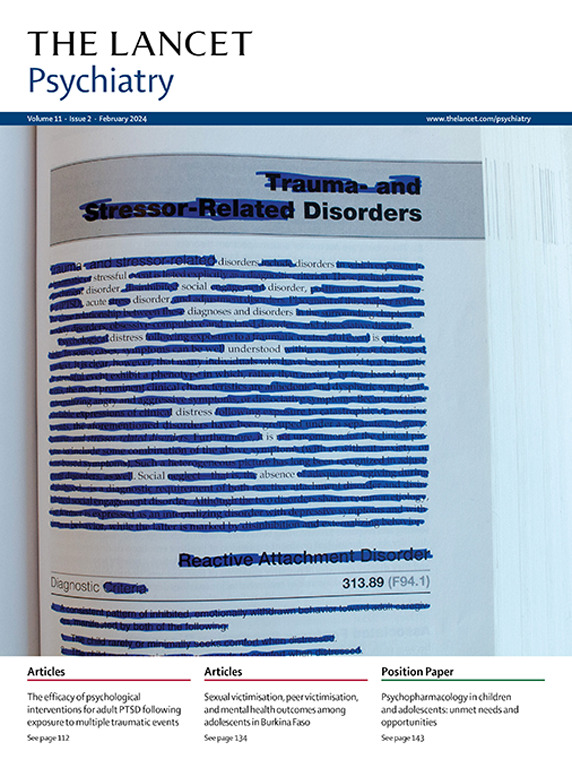Heat and hospital admission via the emergency department for people with intellectual disability, autism, and mental disorders in South Korea: a nationwide, time-stratified, case-crossover study
IF 30.8
1区 医学
Q1 PSYCHIATRY
引用次数: 0
Abstract
Given the anticipated increase in ambient temperature due to climate change, the hazardous effects of heat on health have been extensively studied; however, its impact on people with intellectual disability, autism, and mental illness is largely unknown. We aimed to estimate the association between heat and hospitalisation through the emergency department (ED) among people with these mental disorders. In this nationwide study, we used data from the National Health Insurance Database (NHID) of the National Health Insurance Service, the single universal insurer in South Korea, the claims data for which is based on the ICD-10. We included individuals with identified intellectual disability, autism, and mental disorders (including schizophrenia, bipolar disorder, recurrent depressive disorder, schizoaffective disorder and persistent obsessive-compulsive disorder, Tourette's disorder, and narcolepsy) and we established two control groups of people without these disorders: one including 1 million systematically sampled individuals, and one matched to the cohort based on sex, age, and income group. Data on hospital admission via the ED were obtained from the NHID, including the primary cause of admission and corresponding medical costs, for the warm season (June–September) of the period 2006–2021. We used the Google Earth Engine with the ERA5-Land dataset to collect data on the daily mean temperature. We applied a time-stratified case-crossover design using a distributed lag non-linear model and performed a conditional logistic regression. The risk ratio was estimated as the odds ratio (OR) with calculated odds at the 99th percentile temperature compared with that at the local 75th percentile temperature. We did not include people with lived experience of mental illness in this study. Of the 456 946 people with intellectual disability, autism, or mental disorder in the NHID records, 99 845 were admitted to the ED, including 59 821 (59·9%) males and 40 024 (40·1%) females, and including 29 192 people with intellectual disability, 1428 people with autism, and 69 225 people with mental disorders. We were not able to collect data on ethnicity. The mean age at ED admission was 42·1 years (SD 17·9, range 0–102) for people with intellectual disability, 18·6 years (SD 10·4, range 1–72) for people with autism, and 50·8 years (SD 11·9, range 2–94) for people with mental disorders. The heat OR (odds at the 99th percentile 75th percentile of temperature) of ED admission was 1·23 (95% CI 1·11–1·36) for intellectual disability, 1·06 (0·68–1·63) for autism, and 1·20 (1·12–1·29) for mental disorders. People with intellectual disability, female individuals, people living in rural areas, or those with a low-income status were at increased risk of ED admission due to heat. The risk of ED admission due to genitourinary diseases was higher than that from other causes. Annual increase in medical costs attributable to heat among people with intellectual disability, autism, and mental disorders was US$ 224 970 per 100 000 person-years (95% empirical CI 139 784–305 770). People with intellectual disability, autism, and mental disorders should be included in groups considered at a high-risk for heat exposure, and heat adaptation policies should be implemented with consideration of these groups and their needs. The National Research Foundation of Korea, Korean Ministry of Environment, and Korean Ministry of Education. For the Korean translation of the abstract see Supplementary Materials section.韩国智障、自闭症和精神障碍患者的热量和通过急诊科入院的情况:一项全国性、时间分层、病例交叉研究
鉴于气候变化预计会导致环境温度升高,人们对高温对健康的危害进行了广泛的研究;然而,高温对智障人士、自闭症患者和精神疾病患者的影响在很大程度上还不为人所知。我们的目的是估计高温与这些精神疾病患者通过急诊科(ED)住院之间的关系。在这项全国性研究中,我们使用了韩国唯一的全民保险公司--国民健康保险服务局的国民健康保险数据库(NHID)中的数据,该数据库的理赔数据基于 ICD-10 标准。我们将已确定患有智力障碍、自闭症和精神障碍(包括精神分裂症、双相情感障碍、复发性抑郁障碍、分裂情感障碍和顽固性强迫症、抽动秽语障碍和嗜睡症)的患者纳入研究对象,并建立了两个无这些障碍的对照组:一个对照组包括 100 万名系统抽样患者,另一个对照组则根据性别、年龄和收入组别与队列相匹配。通过急诊室入院的数据来自国家卫生与发展研究所(NHID),其中包括 2006-2021 年暖季(6 月至 9 月)入院的主要原因和相应的医疗费用。我们使用谷歌地球引擎和ERA5-Land数据集收集了日平均气温数据。我们使用分布式滞后非线性模型进行了时间分层病例交叉设计,并进行了条件逻辑回归。风险比被估算为与当地第 75 百分位数温度相比,在第 99 百分位数温度下计算出的几率比(OR)。本研究不包括有精神疾病生活经历的人。在 NHID 记录的 456 946 名智障、自闭症或精神障碍患者中,有 99 845 人被急诊室收治,其中包括 59 821 名男性(59-9%)和 40 024 名女性(40-1%),还包括 29 192 名智障患者、1428 名自闭症患者和 69 225 名精神障碍患者。我们无法收集有关种族的数据。智障人士入院时的平均年龄为 42-1 岁(SD 17-9,范围 0-102),自闭症患者为 18-6 岁(SD 10-4,范围 1-72),精神障碍患者为 50-8 岁(SD 11-9,范围 2-94)。智障者入院急诊室的热OR值(温度第99百分位数第75百分位数的几率)为1-23(95% CI 1-11-1-36),自闭症患者为1-06(0-68-1-63),精神障碍患者为1-20(1-12-1-29)。智障人士、女性、农村居民或低收入人群因高温而入院的风险较高。泌尿生殖系统疾病导致急诊入院的风险高于其他原因。智障、自闭症和精神障碍患者每年因高温而增加的医疗费用为每 10 万人年 224 970 美元(95% 经验 CI 139 784-305 770)。智障人士、自闭症患者和精神障碍患者应被视为高温暴露的高危人群,在实施高温适应政策时应考虑到这些人群及其需求。韩国国家研究基金会、韩国环境部和韩国教育部。摘要的韩文译文见 "补充材料 "部分。
本文章由计算机程序翻译,如有差异,请以英文原文为准。
求助全文
约1分钟内获得全文
求助全文
来源期刊

Lancet Psychiatry
PSYCHIATRY-
CiteScore
58.30
自引率
0.90%
发文量
0
期刊介绍:
The Lancet Psychiatry is a globally renowned and trusted resource for groundbreaking research in the field of psychiatry. We specialize in publishing original studies that contribute to transforming and shedding light on important aspects of psychiatric practice. Our comprehensive coverage extends to diverse topics including psychopharmacology, psychotherapy, and psychosocial approaches that address psychiatric disorders throughout the lifespan. We aim to channel innovative treatments and examine the biological research that forms the foundation of such advancements. Our journal also explores novel service delivery methods and promotes fresh perspectives on mental illness, emphasizing the significant contributions of social psychiatry.
 求助内容:
求助内容: 应助结果提醒方式:
应助结果提醒方式:


